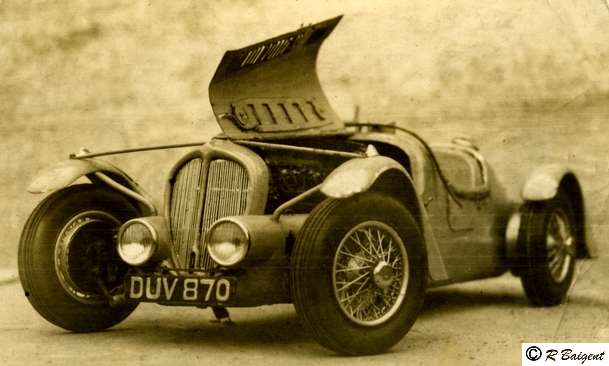
The ex-Bira 1936 Delahaye 135 Sports 6-cyl OHV 3.5 litres Sports

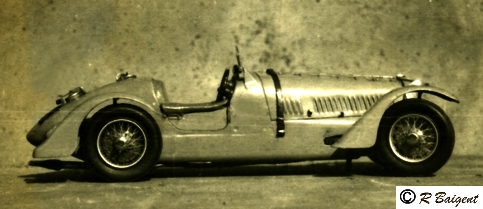
above, photos taken in 1949, model or full-size?
the model after some racing history, click on image to enlarge
above, the full-size car is now at The Haynes Sparkford Motor Museum, Wilts, England, click to enlarge
another example of this car can be seen here: http://members.lycos.nl/kiawallpaper/delahaye5.html
It must be emphasized that this model was powered by a 2.5cc highly tuned diesel engine, so would have be strong enough to race at speeds approaching 60mph, tethered via a high tensile cable to a pole in the centre of a circular track of concrete. This model was the first to have the properly constructed Rudge-Whitworth triple-spoked wheels, in the world, as far as I can remember. They did have a full compliment of 3-rows of interlaced spokes which were made with high-tensile wire. I was working full-time with Henri when this model was made. The radiator was solid brass, cast in a home-made mould. The scraps of brass were chopped up small and heated beyond melting point in a home-made crucible in a small solid-fuel stove. It was my task to cast and fettle the radiator and to thread the wires in into it after cutting them to length, then sweat the whole assembly together. The wires were set in tiny holes drilled with a converted sewing needle. The bonnet was aluminium which was louvered and included adjustable slots as in the original. It was for racing round the pole on R R C Walker's tracks at his home and on the roof of one of his motor dealerships. Henri measured the car in detail as Rob Walker had the original car at his home at Frome, Somerset. The lower part of the chassis was made of hardwood which Henri taught me to carve accurately when I was but a boy. It was prepared and sprayed with his home-made compressor and home-made spray gun. If I remember he sprayed it and I rubbed it down between 10 coats of top quality cellulose. I made the bonnet which opened properly on a centre hinge and was strapped down with leather straps. Henri made the windscreen and seats and beat the wings out of aluminum. The side lights and bonnet, I made, also the press-tool to form the louvres. The most trying job was the forming of the numbers for the registration plates, which I cut out of very thin brass shim by hand with a drill and a set of swiss files. They had to be raised numbers and we mimicked that by soldering them onto brass back-plates. It took a long time and I was proud that I made them but glad when they were finished. The full-sized car raced in Paris Blue, with black trim, and the model was finished in the same livery. This was one of the first seriously detailed cars that we made together and I learnt a lot under Henri's demanding attention while it was produced. As I had been so much involved with this model, I was loth to see it go to the customer, even though I knew that my wages had come from him. This model car was no toy. There was an immense sense of dedication that went into its construction just as if we were building the full-sized car.
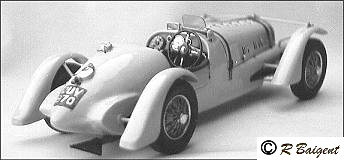

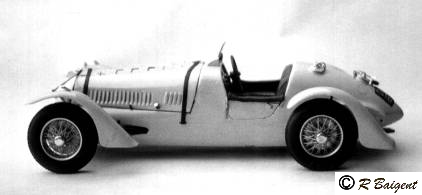

Henri with the Delahaye by the radiator of the Roesch Talbot, both after rebuild.

after refurbishment, Rob Walker had the model put into a clear case
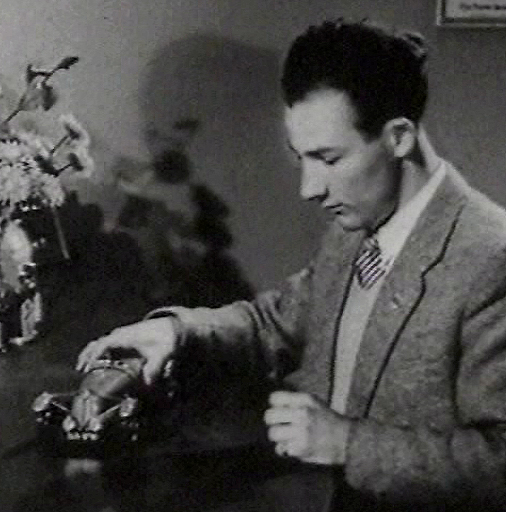
Stirling Moss demonstrating four-wheel drift with the Delahaye model
click on the pictures to see the original article and pictures,
In the April 1949 edition of Model Cars, this one-twelfth scale model Delahaye was the Model of the Month. I will leave the descriptive detail to the editor, Geoffrey Deason who wrote as follows:
"Judged strictly as a model racing car, having due consideration for the meaning of the words, there can be little doubt that this month's subject is the finest so far dealt with in this series. It is a model of a well known car with a definite history, and is moreover, so excellent a replica that it gives the beholder the feeling of looking through the wrong end of a telescope at the original.
To deal briefly with the original, this was the 6-cylinder 3.5 litre Delahaye bought by Prince Chula for [Prince] Bira to drive in sports car races in 1937-8. Bira had mixed luck with it, and after winning the 12 hour sports car race at Donington despite a delayed start (due to oiling all six plugs on the line!) he was forced to withdraw it from the Tourist Trophy, the same year, .taking over one of the B.M.W.s on which he subsequently finished third. The car is now owned by Mr. R. R. C. Walker of Dorking, who has it in full sports-racing trim, and is preparing it for the 24 hours' race at Le Mans this year. Desiring to possess a power-driven model of the car, he approached H. C. Baigent of Ensbury Park, Bournemouth, who agreed to tackle the job forthwith. The work took some four months and the result was as pleasing a model as any that has appeared in the ranks of practical power-driven miniatures. H. C. Baigent has demonstrated on previous occasions that he has an uncanny gift for producing midget-sized replicas which even if not fully detailed, exude the spirit of the full-sized job, as a glance at the two babies in our frontispiece will show. On this occasion he had added all the trimmings to enhance the effect of realism.
Firstly to get the model in proportion it must be appreciated that the overall length is a mere 12.5 in., the track being 4.75 in. and the wheel diameter 2.25 inch over the tread of the tyres.
The main foundation of the car is a wooden base, which is carefully carved to represent the lower portion of the Delahaye's bodywork and under-shielding. The actual power unit is a 2.5 c.c. E.R.E diesel engine of H. C. Baigent's own manufacture, and this is mounted horizontally in the base, with the cylinder facing forward and the offside rear wheel carried on an extension of the crankshaft. Readers may recall that we described the 0.9 c.c. single seater Austin by the same builder in the Nov./Dec., 1947 issue, in which a similar arrangement was employed. A starting pulley takes the place of the brake drum on the wheel in question and a simple and ingenious centrifugal clutch is carried in a drum inside the wheel itself. So neatly is the engine disposed that it does not interfere with the appearance of the cockpit, which normally carries a metal fairing over the passenger's seat for racing occasions.
The front axle is as nearly a scale replica as can be achieved in a working model of this size. A transverse leaf spring of correct proportions is used, with correctly modelled swinging members and dural channel-section radius arms, which run rearwards to anchor on the "chassis" sides. Transverse friction shock absorbers are correct to scale and detail and work in conjunction with the springing movement. The steering arrangement is beautifully worked out in hard brass and is operated by the steering wheel through a proper worm and pinion gear of minute proportions enclosed in a steering box at the lower end of the column. The steering wheel itself is particularly neat, being a realistic replica of the original laminated spring spoke type with ebonite covering for the rim and outer portions of the spokes.
The wheels, to which reference is also made in "Trend of the Trade", are real little works of art, being accurately triple spoked in 26 s.w.g. high tensile steel wire, the spoke-ends being silver soldered in the hard brass rims and hubs. The wheels are then plated and further embellished by the addition of knock-off hub caps made of aluminium which actually screw into the hubs after the wheels are secured on their respective axles by means of 6 B.A. set screws threaded into the axle ends. The tyres are solid, with ribbed treads, and are sprung on to the rims with sufficient grip to allow quite high speed running without tyre fling. The tyre walls are marked 32 E.R.E. 13, the dimensions presumably being rim diameter and tyre section in millimeters. There is no doubt whatever that these wheels are responsible for much of the model's charm, and it would be difficult to achieve true realism without them in a car of this type.
Bodywork is accurately modelled from beaten aluminium sheet on the original very graceful two seater, having the long sloping tail, distinctive radiator and peculiar abbreviated wings which it will be noticed are the same design at front and rear. The bonnet is hinged and contains the correct ventilating doors and is held in place with tiny straps with working fasteners. Under the bonnet is a realistic dummy representation of the six cylinder O.H.V. engine, complete down to the sparking plugs, and fitted with a brass container which forms the engine's base chamber. This does duty as the fuel tank for the 2.5 c.c. engine, and is filled from the upper of the two filler caps on the tail by way of a long plastic tube. These filler caps are worthy of special mention as both the dummy and the real caps open and shut smoothly with the authentic quick-action lever mechanism. In a model of this scale such things are doubly impressive. A third and smaller cap is fitted to the radiator. Cockpit details include glass-fronted instruments, scale gear lever and hand-brake, whilst the inevitable aero-screen is of course present. Another detail which was particularly noticed was the ribbing of the built-in head-lamp glasses, which were modelled from Perspex (Plexiglass).
A flexible exhaust pipe leads rearwards from the downward-pointing exhaust port of the "actual" engine, and terminates in a very convincing fishtail, which we are informed, gives very quiet running. Unfortunately it was impossible to see the model in action, at the time that the photographs were taken, but it is hoped to see it running on the track shortly.
The car is finished, like its big brother, in light blue with black trimmings, and the whole effect is pleasing to a degree. It seems almost a shame to subject a model of this type to the rough and tumble of track running although it certainly appears to be satisfactorily robust in its main features. It can safely be said however, that even if DUV 870's performance, measured in terms of miles per hour, falls short of the speeds registered by its less attractive sisters, this will readily be forgiven by all true lovers of model racing cars in the best sense of the word."